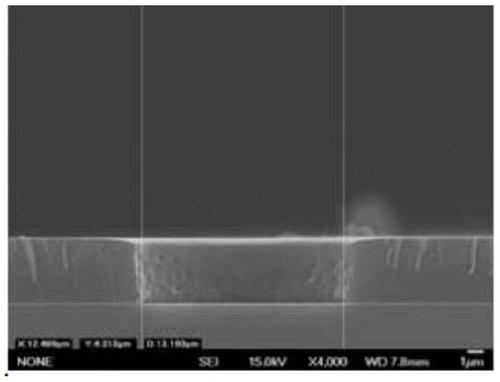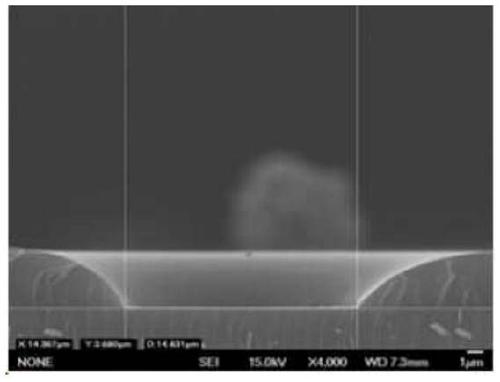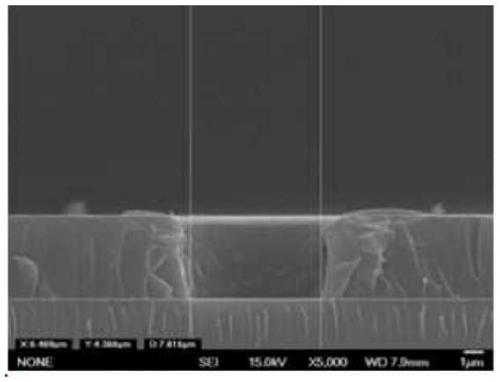Polysilsesquioxane copolymer and photosensitive resin composition comprising the polysilsesquioxane copolymer
A polysilsesquioxane and photosensitive resin technology, applied in the field of photosensitive resin compositions, can solve the problems of outgassing and volume shrinkage, low transmittance, extremely poor heat resistance, etc., and achieve high residual film rate and high adhesive strength. , the effect of easy control of refractive index
- Summary
- Abstract
- Description
- Claims
- Application Information
AI Technical Summary
Problems solved by technology
Method used
Image
Examples
Embodiment
[0104] 1. Synthesis of polysilsesquioxane copolymer (photosensitive resin)
Synthetic example 1
[0106]
[0107] The photosensitive resin represented by Formula 4 was prepared by the following procedure.
[0108] Tetrahydrofuran (40 g) as a solvent and ultrapure water (20 g) were placed in a flask equipped with a stirrer and a thermometer, and then potassium carbonate (0.2 g) as a catalyst was added to the flask. The mixture was stirred to dissolve at room temperature for 20 minutes. To the solution was added methyltrimethoxysilane (0.2 moles). The resulting mixture was allowed to react for 2 hours. 4-(triethoxysilyl)butanoic acid (0.3 mol), trimethoxy(phenyl)silane (0.2 mol), and 3-(triethoxysilyl) were slowly added dropwise to the reaction solution over a period of 30 minutes. base) a mixture of propyl methacrylate (0.3 mol). After the dropwise addition was completed, the reaction was carried out for 8 hours. The reaction mixture was extracted with dichloromethane. Dichloromethane was distilled off under reduced pressure to obtain the target copolymer of formula...
Synthetic example 2
[0111]
[0112] The photosensitive resin represented by Formula 5 was prepared by the following procedure.
[0113] Tetrahydrofuran (40 g) as a solvent and ultrapure water (20 g) were placed in a flask equipped with a stirrer and a thermometer, and then potassium carbonate (0.2 g) as a catalyst was added to the flask. The mixture was stirred to dissolve at room temperature for 20 minutes. Trimethoxy(3-(oxiran-2-ylmethoxy)propyl)silane (0.2 mol) was added to the solution. The resulting mixture was allowed to react for 2 hours. 4-(triethoxysilyl)butanoic acid (0.3 mol), trimethoxy(phenyl)silane (0.2 mol), and 3-(triethoxysilyl) were slowly added dropwise to the reaction solution over a period of 30 minutes. base) a mixture of propyl methacrylate (0.3 mol). After the dropwise addition was completed, the reaction was carried out for 8 hours. The reaction mixture was extracted with dichloromethane. Dichloromethane was distilled off under reduced pressure to obtain the targe...
PUM
| Property | Measurement | Unit |
|---|---|---|
| dispersity | aaaaa | aaaaa |
| polydispersity index | aaaaa | aaaaa |
| polydispersity index | aaaaa | aaaaa |
Abstract
Description
Claims
Application Information
 Login to View More
Login to View More - R&D
- Intellectual Property
- Life Sciences
- Materials
- Tech Scout
- Unparalleled Data Quality
- Higher Quality Content
- 60% Fewer Hallucinations
Browse by: Latest US Patents, China's latest patents, Technical Efficacy Thesaurus, Application Domain, Technology Topic, Popular Technical Reports.
© 2025 PatSnap. All rights reserved.Legal|Privacy policy|Modern Slavery Act Transparency Statement|Sitemap|About US| Contact US: help@patsnap.com



